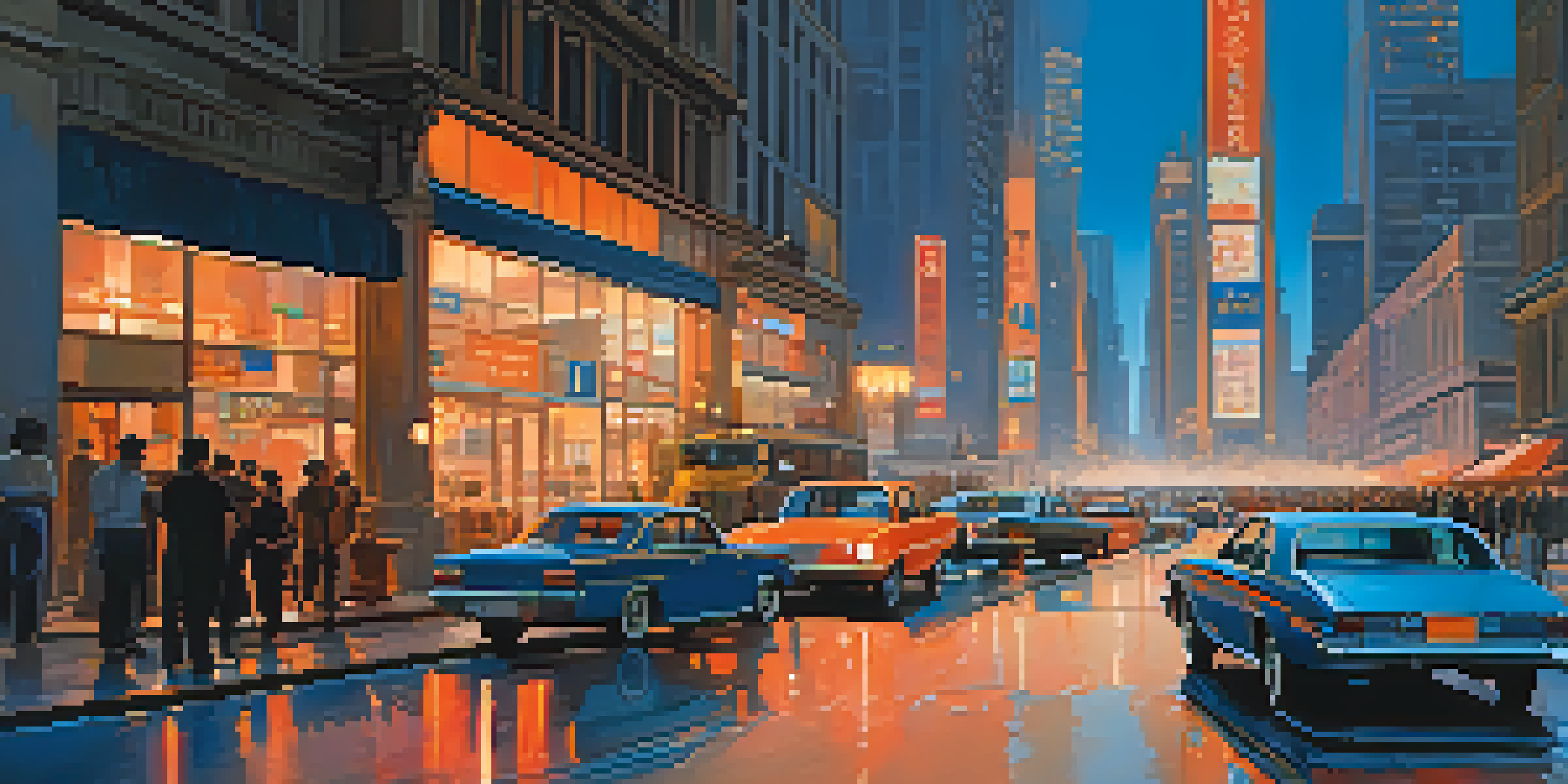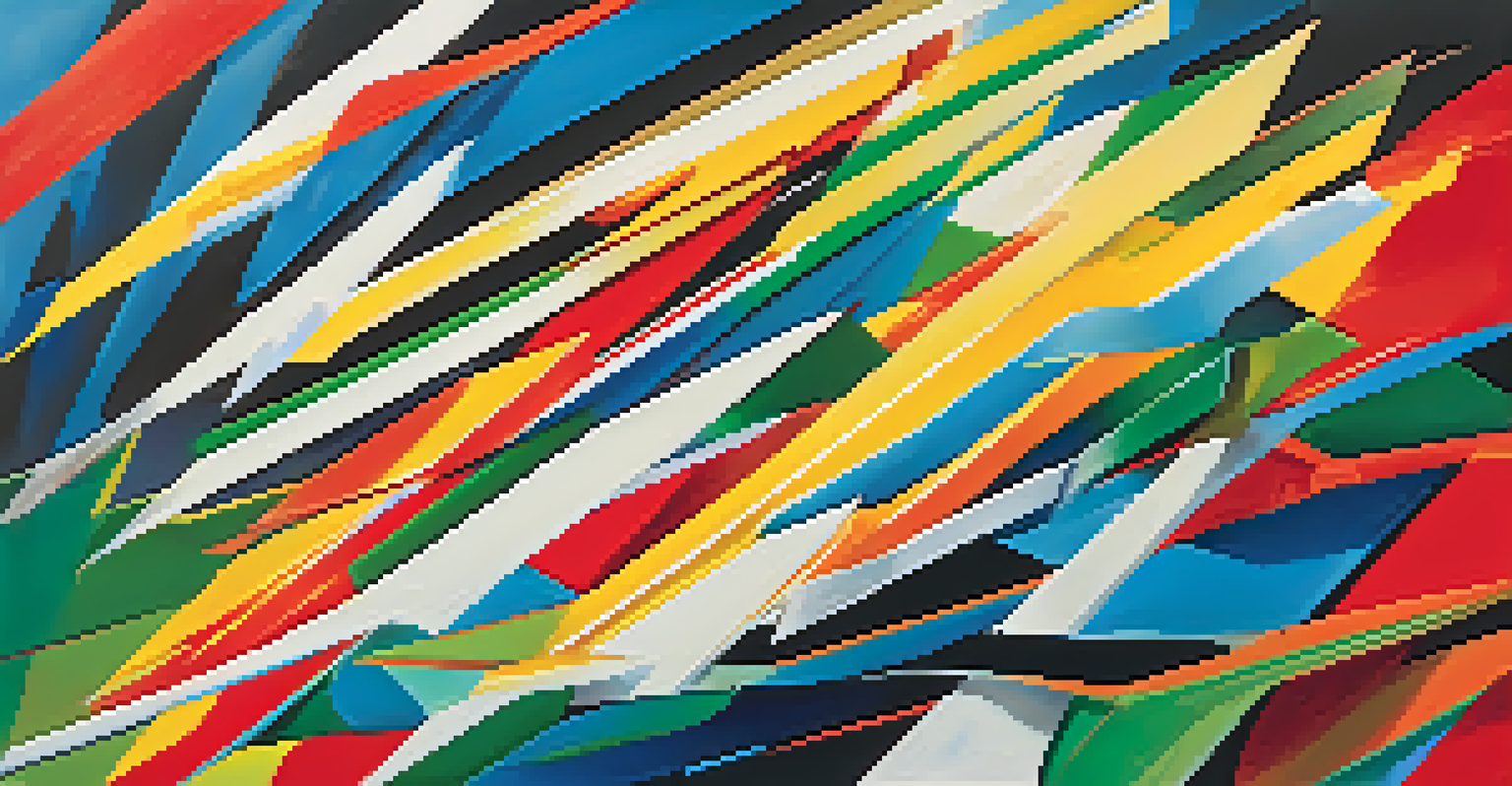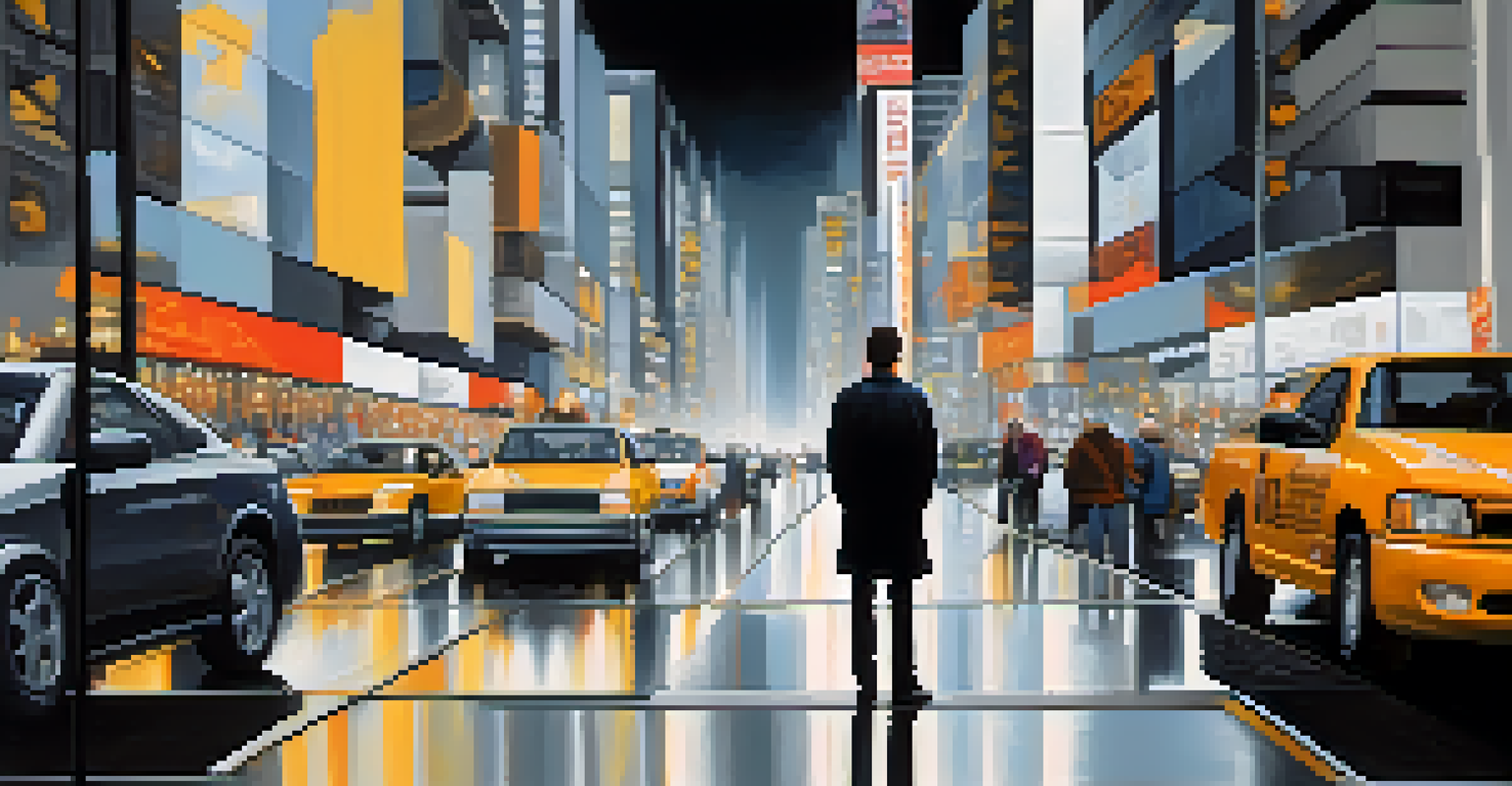Futurism and Urban Life: Reflections in Modern Painting

Understanding Futurism: A Movement Born from Change
Futurism emerged in the early 20th century as a response to rapid industrialization and urbanization. Artists sought to capture the dynamism of modern life, celebrating technology and the speed of machines. This movement was not just about art; it was a cultural shift that reflected the excitement and chaos of contemporary society.
The past is not dead; it is not even past.
The Futurists believed that the past was an anchor holding back progress. They rejected traditional forms of art and embraced bold colors, fragmented forms, and energetic lines to express movement and change. Their works often depicted bustling cityscapes, illustrating how urban life was transforming under the weight of modernity.
Futurism's emphasis on the machine age resonated with many, as it mirrored the experiences of people living in rapidly evolving cities. This artistic movement became a voice for a generation eager to break free from historical constraints and celebrate the new world around them.
The Urban Landscape: Futurism's Canvas of Choice
Urban landscapes became a central theme in Futurist paintings, serving as a backdrop for their exploration of speed and modernity. Artists like Umberto Boccioni and Giacomo Balla infused their works with a sense of movement, capturing the hustle and bustle of city life. They painted not just buildings but the very essence of urban experience.

These artists often depicted scenes filled with cars, trains, and crowds, showcasing the energy and potential of urban environments. By focusing on these subjects, they highlighted how cities were evolving and how technology was reshaping human interaction. The vibrant, chaotic scenes they created reflected both the excitement and anxiety of modern life.
Futurism Celebrates Urban Life
Futurism emerged as an artistic movement that embraced the energy and chaos of modern urban environments, reflecting the excitement of technological advancements.
Through their innovative techniques, Futurist painters transformed ordinary city scenes into dynamic spectacles. They challenged viewers to experience the vibrancy of urban life in a way that transcended mere representation, inviting them to feel the pulse of the modern metropolis.
Color and Motion: Techniques that Define Futurist Art
Futurist artists employed unique techniques to convey movement and energy in their works, often using bold colors and dynamic compositions. They believed that color could express emotion and motion, leading to a vivid visual language that captivated audiences. This approach allowed them to portray the frenetic pace of urban life effectively.
We are all in the gutter, but some of us are looking at the stars.
One prominent technique was the use of diagonal lines and fragmented forms to create a sense of speed. For instance, Boccioni's 'Unique Forms of Continuity in Space' exemplifies this, as it captures a figure in motion, almost merging with the surrounding environment. Such techniques not only highlighted the subject but also transformed the perception of space and time.
The interplay of light and color in Futurist paintings further enhanced the feeling of movement. By layering colors and applying them in quick brushstrokes, artists created a sense of vibrancy that mirrored the excitement of urban life. This innovative use of technique set Futurism apart from other art movements and drew viewers into the experience.
Futurism and the Human Experience in Urban Settings
Futurism was not solely about machines and speed; it also delved into the human experience within urban environments. Artists explored how individuals interacted with the city, often depicting solitary figures amidst the chaos. This juxtaposition of humanity and technology highlighted a complex relationship that defined modern life.
For instance, Balla's paintings often portrayed figures caught in the whirlwind of city life, suggesting a sense of alienation despite the vibrancy around them. These works evoke feelings of both excitement and isolation, reflecting the dual nature of urban existence. The artists were keenly aware of how progress could both liberate and overwhelm individuals.
Dynamic Techniques in Futurist Art
Futurist artists utilized bold colors and innovative techniques, such as diagonal lines, to convey a sense of movement and the frenetic pace of city life.
By focusing on the human element, Futurist artists reminded viewers that behind the machines and urban landscapes were real experiences and emotions. This connection to the human condition added depth to their works, inviting audiences to contemplate their place in the rapidly changing world.
The Role of Technology in Futurist Urban Art
Technology played a pivotal role in shaping the aesthetics and themes of Futurist art. The introduction of new machines and inventions inspired artists to celebrate innovation and progress. This enthusiasm for technology was not merely a backdrop; it became a crucial element of their artistic expression.
Futurists viewed technology as a force that could enhance human experience, pushing boundaries and transforming daily life. Their works frequently featured modern inventions like airplanes, automobiles, and trains, symbolizing the possibilities of the future. These elements became iconic representations of the urban landscape, embodying the spirit of the age.
However, the relationship between technology and art was complex. While Futurists embraced modernity, they also recognized its potential drawbacks. This duality is reflected in their paintings, where the celebration of technology often coexists with themes of alienation and disconnection, prompting viewers to reflect on the implications of progress.
Legacy of Futurism in Contemporary Urban Art
The influence of Futurism extends far beyond its time, leaving a lasting mark on contemporary urban art. Today, artists continue to explore themes of movement, technology, and urban life, often drawing inspiration from Futurist principles. This ongoing dialogue highlights the relevance of Futurism in understanding modern cities.
Many contemporary artists incorporate elements of Futurism in their works, using vibrant colors and dynamic compositions to reflect the energy of urban environments. By revisiting these themes, they not only honor the past but also respond to the ongoing changes in our cities. This connection creates a bridge between historical movements and current artistic practices.
Legacy of Futurism in Modern Art
The principles of Futurism continue to influence contemporary artists, as they explore themes of movement, technology, and urban existence in their works.
Furthermore, as cities evolve with new technologies and social challenges, the Futurist perspective becomes increasingly significant. Artists today grapple with issues of sustainability, connectivity, and identity in urban spaces, echoing the Futurist vision of a dynamic and ever-changing world.
Conclusion: Futurism's Enduring Impact on Art and Society
Futurism's exploration of urban life and modernity continues to resonate in today's artistic landscape. By challenging traditional forms and celebrating the dynamism of the machine age, Futurist artists laid the groundwork for future movements. Their legacy endures in the works of contemporary artists who grapple with similar themes.
As we navigate our rapidly changing urban environments, the reflections of Futurism remind us of the complexities of modern life. This movement encourages us to not only embrace progress but also to consider its impact on our experiences and relationships within cities. The balance between innovation and humanity remains a crucial conversation.

Ultimately, Futurism serves as a lens through which we can examine our own urban experiences. By understanding its principles and embracing its spirit, we can appreciate the vibrancy of our cities while recognizing the challenges that come with modernity.